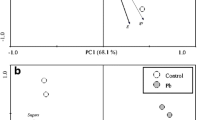Abstract
Major endogenous biochemical properties can make plants ideal agents for metal/metalloid-contaminated site cleanup. This study investigates the biochemistry of Juncus maritimus (Lam) roots for its high mercury (Hg) stabilization potential in the sediments of the Ria de Aveiro coastal lagoon (Portugal), which received Hg-rich effluents from a chlor–alkali industry between 1950 and 1994. J. maritimus plants were collected at a reference (R) site and three sites with the highest (L1), moderate (L2), and the lowest (L3) Hg contamination levels. The highest Hg-harboring/stabilizing J. maritimus roots at L1, exhibited significantly elevated damage endpoints (H2O2; lipid peroxidation, LPO; electrolyte leakage, EL; protein oxidation, PO; proline) which were accompanied by differential changes in H2O2-metabolizing defense system components (ascorbate peroxidase, catalase, glutathione peroxidase, glutathione S-transferase), glutathione reductase and the contents of both reduced and oxidized glutathione. Trends in measured endpoints reached maximum levels at L1 followed by L2 and L3. Cross-talks on root–Hg status and the studied biochemical traits revealed (a) high Hg-accrued elevations in oxidative stress as an obvious response; (b) Hg-stabilization potential of J. maritimus roots as a result of a successful mitigation of elevated high Hg-induced H2O2, and its anomalies such as LPO, EL, and PO; and (c) the induction of and a fine synchronization between non-glutathione and glutathione-based systems. Overall, the study unveiled biochemical mechanisms underlying root tolerance to Hg burden-accrued anomalies which, in turn, helped J. maritimus during Hg-stabilization.




Similar content being viewed by others
References
Aebi H (1984) Catalase in vitro. Method Enzymol 105:121–130
Ahmad I, Mohmood I, Coelho JP, Pacheco M, Santos MA, Duarte AC, Pereira E (2012) Role of non-enzymatic antioxidants on the bivalves’ adaptation to environmental mercury: Organ-specificities and age effect in Scrobicularia plana inhabiting a contaminated lagoon. Environ Pollut 163:218–225
Ali H, Khan E, Sajad MA (2013) Phytoremediation of heavy metals—concepts and applications. Chemosphere 91:869–881
Anderson ME (1985) Determination of glutathione and glutathione disulfides in biological samples. Method Enzymol 113:548–570
Anjum NA, Ahmad I, Rodrigues SM, Henriques B et al (2013) Eriophorum angustifolium and Lolium perenne metabolic adaptations to metals- and metalloids-induced anomalies in the vicinity of a chemical industrial complex. Environ Sci Pollut Res 20:568–581
Anjum NA, Ahmad I, Válega M, Mohmood I et al (2014a) Salt marsh halophyte services to metal-metalloid remediation: assessment of the processes and underlying mechanisms. Crit Rev Environ Sci Technol 44:2038–2106
Anjum NA, Israr M, Duarte AC, Pereira ME, Ahmad I (2014b) Halimione portulacoides (L.) physiological/biochemical characterization for its adaptive responses to environmental mercury exposure. Environ Res 131:39–49
Anjum NA, Duarte AC, Pereira E, Ahmad I (2014c) Oxidative stress status, antioxidant metabolism and polypeptide patterns in Juncus maritimus shoots exhibiting differential mercury-burdens in Ria de Aveiro coastal lagoon (Portugal). Environ Sci Pollut Res 21:6652–6661
Anjum NA, Ahmad I, Válega M, Pacheco M et al (2012a) Salt marsh macrophyte Phragmites australis strategies assessment for its dominance in mercury-contaminated coastal lagoon (Ria de Aveiro, Portugal). Environ Sci Pollut Res 19:2879–2888
Anjum NA, Ahamd I, Mohmood I, Pacheco M, Duarte AC et al (2012b) Modulation of glutathione and its related enzymes in plants’ responses to toxic metals and metalloids—a review. Environ Exp Bot 75:307–324
Anjum NA, Ahmad I, Válega M, Pacheco M et al (2011) Impact of seasonal fluctuations on the sediment-mercury, its accumulation and partitioning in Halimione portulacoides and Juncus maritimus collected from Ria de Aveiro coastal lagoon (Portugal). Water Air Soil Pollut 222:1–15
Bates LS, Waldran RP, Teare ID (1973) Rapid determination of free proline for water stress studies. Plant Soil 39:205–208
Boominathan R, Doran PM (2002) Ni-induced oxidative stress in roots of the Ni hyperaccumulator, Alyssum bertolonii. New Phytol 156:205–215
Castro R, Pereira S, Lima A, Corticeiro S, Válega M et al (2009) Accumulation, distribution and cellular partitioning of mercury in several halophytes of a contaminated salt marsh. Chemosphere 76:1348–1355
Foyer CH, Halliwell B (1976) The presence of glutathione and glutathione reductase in chloroplasts: a proposed role in ascorbic acid metabolism. Planta 133:21–25
Gill SS, Anjum NA, Ahmad I, Thangavel P, Sridevi G, Pacheco M et al (2012) Metal hyperaccumulation and tolerance in Alyssum, Arabidopsis and Thlaspi: an overview. In: Anjum NA, Ahmad I et al (eds) The Plant Family Brassicaceae. Springer, Netherlands, pp 99–137
Levine RL, Willians JA, Stadtman ER, Shacter E (1994) Carbonyl assays for determination of oxidatively modified proteins. Method Enzymol 233:346–363
Maestri E, Marmiroli M, Visioli G, Marmiroli N (2010) Metal tolerance and hyperaccumulation: costs and trade-offs between traits and environment. Environ Exp Bot 68:1–13
Marques B, Lillebø AI, Pereira E, Duarte AC (2011) Mercury cycling and sequestration in salt marshes sediments: an ecosystem service provided by Juncus maritimus and Scirpus maritimus. Environ Pollut 159:1869–1876
Meagher RB (2000) Phytoremediation of toxic elemental and organic pollutants. Curr Opin Plant Biol 3:153–162
Nakano Y, Asada K (1981) Hydrogen peroxide is scavenged by ascorbate-specific peroxidase in spinach chloroplasts. Plant Cell Physiol 22:867–880
Patra M, Sharma A (2000) Mercury toxicity in plants. Bot Rev 66:379–422
Pereira ME, Lillebø AI, Pato P, Válega M et al (2009) Mercury pollution in Ria de Aveiro (Portugal): a review of the system assessment. Environ Monit Assess 155:39–49
Randall PM, Chattopadhyay S (2013) Mercury contaminated sediment sites— an evaluation of remedial options. Environ Res 125:131–149
Shulaev V, Oliver DJ (2006) Metabolic and proteomic markers for oxidative stress–new tools for reactive oxygen species research. Plant Physiol 141:367–372
Sobrino-Plata J, Ortega-Villasante C, Laura Flores-Cáceres M et al (2009) Differential alterations of antioxidant defenses as bioindicators of mercury and cadmium toxicity in alfalfa. Chemosphere 77:946–954
Szabados L, Savoure A (2010) Proline: a multifunctional amino acid. Trend Plant Sci 15:89–97
Acknowledgments
Financial support received from both FCT (Government of Portugal) through contract (FRH/BPD/64690/2009; SFRH/BPD/84671/2012) and the Aveiro University Research Institute/CESAM is gratefully acknowledged.
Author information
Authors and Affiliations
Corresponding author
Additional information
Responsible editor: Philippe Garrigues
Rights and permissions
About this article
Cite this article
Anjum, N.A., Duarte, A.C., Pereira, E. et al. Juncus maritimus root biochemical assessment for its mercury stabilization potential in Ria de Aveiro coastal lagoon (Portugal). Environ Sci Pollut Res 22, 2231–2238 (2015). https://doi.org/10.1007/s11356-014-3455-x
Received:
Accepted:
Published:
Issue Date:
DOI: https://doi.org/10.1007/s11356-014-3455-x




